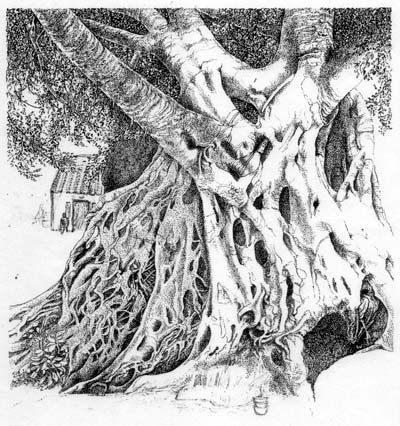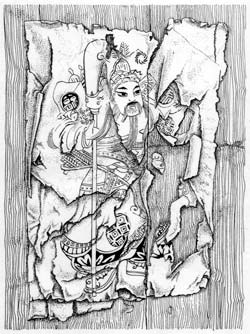
Tai Long Wan -- Tales from a vanishing village
by Keith Addison
Tai Long Wan village, Shek Pik, Lantau, Hong Kong, 1983-85
|
Stories by Keith Addison |
| Tai Long Wan -- Tales from a vanishing village Introduction |
|
Tea money |
|
Back to basics |
|
Forbidden fruit |
|
A place where nothing happens |
|
No sugar |
|
Treasure in a bowl of porridge |
|
Hong Kong and Southeast Asia -- Journalist follows his nose |
| Nutrient Starved Soils Lead To Nutrient Starved People |
|
Cecil Rajendra A Third World Poet and His Works |
|
Leave the farmers alone Book review of "Indigenous Agricultural Revolution -- Ecology and Food Production in West Africa", by Paul Richards |
|
A timeless art Some of the finest objects ever made |
|
Health hazards dog progress in electronics sector The dark side of electronics -- what happens to the health of workers on the production line |
|
Mo man tai ('No problem') -- "Write whatever you like" -- a weekly column in Hong Kong Life magazine Oct. 1994-Jan. 1996 |
|
Swag bag Death of a Toyota |
|
Zebra Crossing -- On the wrong side of South Africa's racial divide.
|
|
Curriculum Vitae |
|
|

Illustrations by Christine Thery
HALF-hidden in a fold in the mountainside, an old Buddhist monastery stood in a neglected garden, with a mass of creeper weed pouring in over the rusted fence from the woods beyond.
A green longhorn grasshopper leapt into flight from a rose-of-China bush in the garden and headed for the creeper, but a black and yellow wasp slammed into it in mid-flight, its sting stabbing into the longhorn's belly. The lacy green wings went limp, and wasp and prey plunged to the ground.
The wasp scrambled to its feet, took a fresh grip on the stunned grasshopper and tried to take off, but the longhorn was too heavy. Instead, its wings beating, the wasp began to drag the limp body along the ground, heading towards an old bamboo ladder left standing long before against the monastery wall three metres away. It reached the nearest leg of the ladder and started to climb, its wings a blur, the slope of the ladder just sufficient for it to struggle upwards with the grasshopper. It inched up to the fourth rung, then turned and leapt into space with its prey.
The weight took effect and they swooped down, but gathered just enough speed for the wasp's thrashing wings to gain lift, and they cleared the fence and swerved off between the trees, dropping heavily to the ground beside a little mound of fresh earth heaped on top of the sandy soil. The wasp cleared away the mound, exposing a hole; it gripped the grasshopper by the head with its jaws and dragged it backwards into the hole. After a few minutes the wasp emerged, sealed up the entrance with mud cemented with spit, covered it with sand and flew away, never to return.
A wasp's powerful sting can hurt a human and kill some of its enemies, but it can also drug a cockroach so that it can be led away by a feeler, or paralyse a big wolf-spider or a grasshopper, preserving it alive for weeks after the sting. Inside the burrow, beside the motionless longhorn, lay an egg, soon to hatch into a maggot, with enough live food laid by to last until pupation and its emergence as a wasp, by which time the unfortunate grasshopper would finally be dead.
Not many things will attack a wasp, but its eggs and larvae, though protected and provisioned, are more vulnerable to predators, for nature prunes and weeds with one hand what she nurtures so lovingly with the other.
The old monastery had been deserted for many years. Beyond the fence, slightly up the hillside where the forces of heaven and earth wove harmonious patterns, was the grave of an old nun. When she died her younger sisters moved to a bigger monastery nearby. One of them came to burn incense at the grave every day, and before the statue of the Buddha sitting on his lotus inside the monastery in contemplation of the turning Wheel, the endless dance of life and death.
The grave looked out over the remains of a small orchard which had provided the nuns with tangerines and oranges, mandarins, pomoloes, lichees, guavas, custard apples, papayas and bananas. The creeper had reclaimed the orchard, climbing and strangling the last of the fruit trees, while others lay rotting on the ground, their crumbling wood host to hordes of grubs, beetles, ants, woodlice, fungi and microbes, grinding it up into the soil to nurture new life.
Seeds sown by the wild trees and shrubs which follow the creeper were already sprouting, unmolested by the creeper, which dies back as the trees grow and their roots spread, their falling leaves laying a protective carpet over the soil, and feeding the earthworms and myriads of tiny creatures on which fertility depends. Eventually the land would be restored, what the nuns took from it replaced.
A stream flowed past the end of the orchard and through the woods beyond, finally plunging into a water gully cut across the slope. After a typhoon the two-metre-deep cement gully was a torrent, but with the big rains yet to come, only a few inches of water flowed in the shallow ditch at the bottom.
A big mitten crab, its pincers covered in coarse dark hair, scurried through the water. It had fallen into the culvert from the stream, and there was no escape for 50 metres downstream, where the gully spilt into a pool. The crab was exposed and rushed along as fast as it could.
With a flash of blue, a kingfisher landed at the edge of the gully and peered down at the crab. It hopped to the edge of the ditch and lanced its powerful beak down at the crab's carapace, but the crab was well armoured and withstood the blows -- it wedged itself against the bottom edge of the ditch with its claws, and the probing, levering beak could not dislodge it.
Baffled, the bird returned to the wall, and the crab scrambled on. The bird pounced again, but the crab saw it coming and lunged up out of the water with its pincers lashing, and the kingfisher leapt back in alarm. The crab hurried on, but the bird flew ahead to lie in wait, and then the beak stabbed down at the same spot on the crab's back, aiming to weaken it; the crab lunged up again and the bird sprang back; the crab hurried on, but the bird was there again, pecking, struggling to pry it loose. In spite of the bird's assault, the crab was making good progress towards the pool. It reached the edge and scrambled over, dropping a couple of metres to the deeper water and sinking to the bottom. The kingfisher shrieked and flew off.
On the far side of the pool a half-grown cobra swam along the smooth cement wall, trying to find a way out. It circled the pool twice before it gained a grip in a hairline crack in the cement. The muscles rippling down its flanks, its scales bit into the crack and it edged upwards, until it was high enough up the wall to reach a dead branch hanging over the edge. It coiled up the branch, slipped over the wall and into the undergrowth.
Just then two figures appeared on the path at the edge of the pool, an old Chinese villager and his young grandson, the man carrying a pole with a net at the end and the boy holding a toy rifle, the kind that fires safe plastic pellets. He spotted a small frog squatting on a stone jutting from the pool, levelled the toy, aimed and pulled the trigger, and the frog flopped into the water and floated belly-up. They laughed, delighted with the good shot.
The old man finished his cigarette and tossed the end into the pool, and, spotting a movement on the bottom as the butt hit the surface, he discovered the still-nervous mitten-crab. He lowered the net into the water and poked it at the crab, startling it into movement again, and deftly netted it.
The boy cheered as he hoisted the prize to the bank. Again he probed in the pool with the net, and caught two more crabs.
 Pleased with their catch, the pair departed. The path followed a stream down through a small wood to a series of flooded rice terraces studded with bright green young plants, and across to the village, two rows of old stone houses with steeply pitched red-tiled roofs, shaded by a big banyan and dragon's eye trees, a fung shui wood on the slopes behind. At the foot of the old banyan tree stood a small shrine, a flat slab of granite in front of a strangely shaped rock, where incense burnt morning and evening. At each doorway stood spirit guardians, paper warriors pasted on either side of the door at Lunar New Year to keep ghosts out. Inside, on the back wall facing the door, hung a small round mirror in an eight-sided bright green wooden frame with the eight trigrams of change painted in bright red, to repel any evil spirit gaining entrance by confronting it with its own horrible image.
Pleased with their catch, the pair departed. The path followed a stream down through a small wood to a series of flooded rice terraces studded with bright green young plants, and across to the village, two rows of old stone houses with steeply pitched red-tiled roofs, shaded by a big banyan and dragon's eye trees, a fung shui wood on the slopes behind. At the foot of the old banyan tree stood a small shrine, a flat slab of granite in front of a strangely shaped rock, where incense burnt morning and evening. At each doorway stood spirit guardians, paper warriors pasted on either side of the door at Lunar New Year to keep ghosts out. Inside, on the back wall facing the door, hung a small round mirror in an eight-sided bright green wooden frame with the eight trigrams of change painted in bright red, to repel any evil spirit gaining entrance by confronting it with its own horrible image.
The old man and his grandson stopped at the third house in the front row. The boy rushed in shouting as his grandmother came to greet them. Soon the old woman was steaming the three crabs for the evening meal. Mitten crabs are good to eat, but they're also host to a killer parasite which can take root in a person's lungs, eventually ruining them, and invading the spinal chord and finally the brain. It's not always killed by steaming the crabs.
From the village a steep path wound up the mountain slope and over the ridge to a high plateau dominated by a stone temple. Behind the massive wooden doors, kneeling on a cushion on the red-tiled floor before a large statue of the Buddha, a nun chanted the sutras, her left hand holding a hollow gourd, her right a short stick with which she tapped out a monotonous rhythm, like a pulse.











